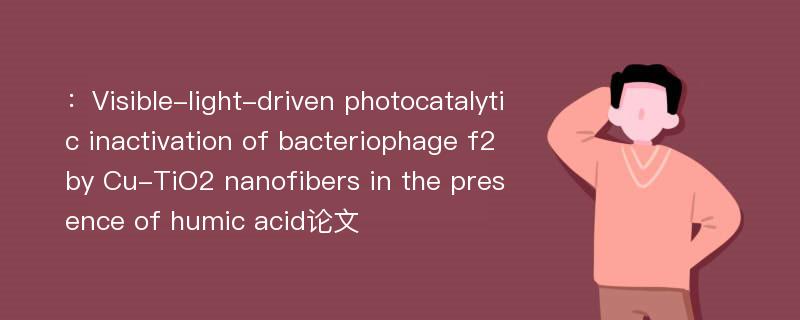
本文主要研究内容
作者(2019)在《Visible-light-driven photocatalytic inactivation of bacteriophage f2 by Cu-TiO2 nanofibers in the presence of humic acid》一文中研究指出:Pathogenic viruses in drinking water are great threats to public health. Visible-lightdriven photocatalysis is a promising technology for virus inactivation. However, the existing photocatalytic antiviral research studies have mostly been carried out in single-component systems, neglecting the effect of natural organic matter, which exists widely in actual water bodies. In this paper, electrospun Cu-TiO2 nanofibers were prepared as photocatalysts, and their photocatalytic antiviral performance in the presence of humic acid(HA) was comprehensively studied for the first time. The properties of the reaction mixture were measured during the reaction. In addition, the safety, reliability and stability of photocatalytic disinfection in the mixed system were evaluated. The results showed that the virus removal efficiency decreased with the increase of the HA concentration. The type of reaction solution, such as PBS buffer solution or water, did not affect the removal efficiency noticeably. Under acidic conditions, the electrostatic forces between photocatalysts and viruses were strengthened, leading to higher virus removal efficiency. As the reaction time went on, the pH value in the solution increased first and then tended to be stable, the conductivity remained stable, and the dissolved oxygen increased first and then decreased. The safety test showed that the concentration of Cu ions released into the solution was lower than specified by the international standards. No photoreactivation was observed, and the addition of HA significantly reduced the reutilization efficiency of the photocatalysts.
Abstract
Pathogenic viruses in drinking water are great threats to public health. Visible-lightdriven photocatalysis is a promising technology for virus inactivation. However, the existing photocatalytic antiviral research studies have mostly been carried out in single-component systems, neglecting the effect of natural organic matter, which exists widely in actual water bodies. In this paper, electrospun Cu-TiO2 nanofibers were prepared as photocatalysts, and their photocatalytic antiviral performance in the presence of humic acid(HA) was comprehensively studied for the first time. The properties of the reaction mixture were measured during the reaction. In addition, the safety, reliability and stability of photocatalytic disinfection in the mixed system were evaluated. The results showed that the virus removal efficiency decreased with the increase of the HA concentration. The type of reaction solution, such as PBS buffer solution or water, did not affect the removal efficiency noticeably. Under acidic conditions, the electrostatic forces between photocatalysts and viruses were strengthened, leading to higher virus removal efficiency. As the reaction time went on, the pH value in the solution increased first and then tended to be stable, the conductivity remained stable, and the dissolved oxygen increased first and then decreased. The safety test showed that the concentration of Cu ions released into the solution was lower than specified by the international standards. No photoreactivation was observed, and the addition of HA significantly reduced the reutilization efficiency of the photocatalysts.
论文参考文献
论文详细介绍
论文作者分别是来自Journal of Environmental Sciences的,发表于刊物Journal of Environmental Sciences2019年03期论文,是一篇关于,Journal of Environmental Sciences2019年03期论文的文章。本文可供学术参考使用,各位学者可以免费参考阅读下载,文章观点不代表本站观点,资料来自Journal of Environmental Sciences2019年03期论文网站,若本站收录的文献无意侵犯了您的著作版权,请联系我们删除。
